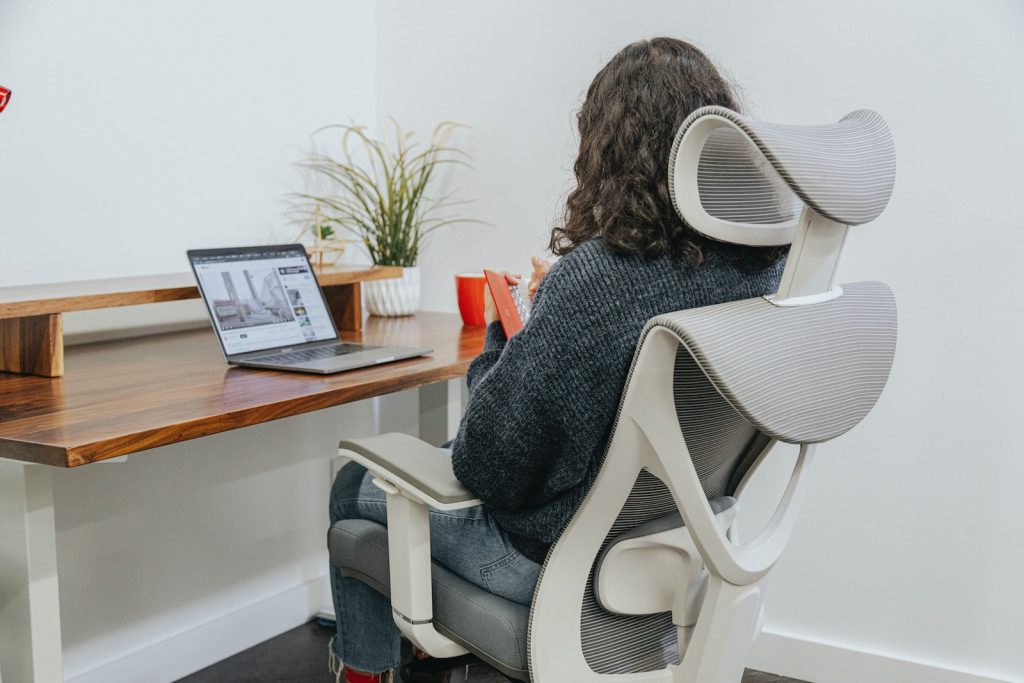Ergonomics and Workplace Wellness
What is ergonomics?
Ergonomics in the workplace refers to the design and arrangement of workspaces, equipment, and tasks to optimise the well-being, comfort, and productivity of employees. It focuses on creating a workspace that minimises physical strain and discomfort, thereby reducing the risk of musculoskeletal problems and enhancing overall job satisfaction.
There is a rising prevalence of shoulder and back pain among office workers due to factors such as prolonged sitting, poor posture, and repetitive tasks. Many office workers experience discomfort and pain in these areas, which can affect their quality of life and job performance.
Physiotherapy plays a crucial role in addressing shoulder and back pain among office workers. Physiotherapists provide personalized assessments, treatments, and exercises to alleviate pain, improve posture, and prevent future issues. They help individuals maintain their physical well-being in sedentary office environments, promoting comfort, productivity, and long-term health.

The Modern Workplace and Its Challenges
The shift towards sedentary work environments refers to the increasing prevalence of jobs where employees spend most of their workday sitting at a desk or computer, with minimal physical movement. This shift has become more prominent due to technological advances, changes in job roles, and shifts in workplace culture. While it offers benefits such as improved productivity and convenience, it also comes with several drawbacks, including negative impacts on physical health.
Extended periods of sitting can lead to various health issues, including shoulder and back pain. Prolonged sitting causes certain muscle groups, particularly those in the back and core, to weaken while others, like the hip flexors, become tight and overused. This muscle imbalance can lead to poor posture and discomfort. Sitting for hours can compress the spinal discs, leading to conditions like herniated discs or degenerative disc disease, which contribute to back pain. Sitting for long periods can restrict blood flow and lead to muscle stiffness, making it easier to develop painful conditions.
Improperly designed workstations and poor ergonomics exacerbate the negative effects of prolonged sitting. Chairs, desks, and computer setups that don’t support proper posture can encourage slouching and hunching, leading to discomfort and pain in the upper back and shoulders. Chairs lacking adequate lumbar support can fail to maintain the natural curve of the lower spine, causing lower back pain. Incorrect monitor placement can lead to neck and shoulder strain as employees tilt their heads or hunch their shoulders to view the screen. Staying in the same seated position for extended periods without breaks can result in muscle stiffness and reduced circulation, contributing to discomfort in the shoulders and back.
Addressing these issues involves implementing ergonomic principles, which include properly adjusted chairs, desks, and computer equipment. Encouraging regular breaks for stretching and movement can also help alleviate the negative effects of prolonged sitting. Proper posture awareness and exercises to strengthen the back and core muscles are essential components of mitigating shoulder and back pain in sedentary work environments.
Understanding Shoulder Pain and Its Causes
Shoulder pain is a discomfort or soreness that occurs in and around the shoulder joint. Common symptoms of shoulder pain include:
- Pain: Typically felt as a dull ache, sharp pain, or throbbing sensation in the shoulder region.
- Limited Range of Motion: Difficulty in moving the shoulder joint fully or without pain, leading to restricted arm movement.
- Stiffness: A sensation of tightness or reduced flexibility in the shoulder area.
- Weakness: A decrease in the strength of the affected arm, making it challenging to perform routine activities.
- Instability: Feeling as if the shoulder might dislocate or “give way” when performing certain movements.
- Radiating Pain: Pain may extend from the shoulder to the neck, upper back, or down the arm.
- Swelling and Inflammation: In some cases, the shoulder may appear swollen or inflamed, especially if there’s an underlying injury or condition.
- Clicking or Popping Sensation: Some individuals may experience audible or palpable clicking or popping noises when moving the shoulder.

Shoulder pain can result from various causes, including injuries, overuse, muscle strains, tendonitis, arthritis, nerve compression, and underlying medical conditions. Accurate diagnosis and appropriate treatment are essential to address shoulder pain effectively.
Shoulder pain can have various causes, and both poor posture and repetitive strain are common contributors, especially in office settings. 60.2% of office workers surveyed had poor sitting posture.
- Poor Posture:
– Forward Head Posture: Leaning forward to read a computer screen or type on a keyboard for extended periods can lead to a forward head posture. This places extra strain on the neck and shoulders.
– Slouched Shoulders: Hunching or slouching while sitting can lead to rounded shoulders, causing muscle imbalances and discomfort in the upper back and shoulders.
– Sitting Position: Prolonged sitting with poor ergonomics can result in poor posture, leading to shoulder pain over time.
2. Repetitive Strain:
– Repetitive Movements: Tasks like typing on a keyboard, using a mouse, or performing repetitive office work without proper ergonomics can strain the shoulder muscles and tendons.
– Overhead Activities: Jobs that involve frequent overhead movements, such as lifting, reaching, or stocking shelves, can lead to shoulder strain and pain.
Addressing shoulder pain often involves a combination of ergonomic improvements, physical therapy, medication, and, in some cases, surgical intervention. Prevention through proper posture, ergonomics, and regular breaks from repetitive tasks is essential in reducing the prevalence of shoulder pain in office settings.
Back Pain: A Growing Concern
Back pain is a common health issue characterized by discomfort or soreness in the area between the neck and the hips. It can be acute (lasting a few days to a few weeks) or chronic (lasting three months or more). Back pain can range from mild, temporary discomfort to severe, disabling pain, and it can significantly impact an individual’s quality of life.
Types of Back Pain:
- Muscle or Ligament Strain: This is one of the most common types of back pain and often results from sudden movements, overuse, or poor lifting techniques. It typically affects the lower back.
- Herniated or Bulging Disc: When the soft tissue between the spinal vertebrae (disc) ruptures or bulges, it can press on nerves, causing pain. This pain can radiate down the legs and is often referred to as sciatica.
- Osteoarthritis: Degeneration of the spinal joints can lead to osteoarthritis, causing chronic back pain, stiffness, and reduced flexibility.
- Spinal Stenosis: This condition involves the narrowing of the spinal canal, which can compress the spinal cord and nerves, leading to pain, tingling, and weakness in the back and legs.
- Scoliosis: Abnormal curvature of the spine can result in back pain, especially in severe cases.
Common Symptoms of Back Pain:
– Dull, aching pain: The pain can vary in intensity and may come and go.
– Stiffness: Reduced flexibility and difficulty in bending or twisting.
– Radiating pain: Pain that travels to other parts of the body, such as the legs (sciatica).
– Muscle spasms: Sudden, involuntary muscle contractions.
– Sharp, shooting pain: Occurs with certain movements or positions.
– Numbness or tingling: Sensations in the back or down the legs.
Causes of Back Pain:
- Incorrect Posture: Poor posture, such as slouching or hunching, places excessive strain on the spine and its supporting muscles, leading to muscle imbalances and pain.
- Heavy Lifting: Lifting heavy objects with improper techniques can strain the muscles and ligaments in the back, causing acute or chronic pain.
- Prolonged Sitting: Sitting for extended periods, especially in poorly designed ergonomic chairs or without breaks, can lead to muscle stiffness, weakening, and back pain.
Back pain can significantly impact employee productivity and absenteeism in the workplace. Employees suffering from back pain may have difficulty focusing on their tasks and performing at their best. They may take longer breaks or frequent absences to alleviate discomfort. Severe or chronic back pain can lead to extended sick leave, which can disrupt workflow and increase workloads for colleagues. Employees experiencing chronic back pain may become dissatisfied with their job due to pain-related limitations and discomfort. Employers may incur higher healthcare costs due to medical treatments, physical therapy, and interventions for employees with back pain

To mitigate the impact of back pain on employee productivity and absenteeism, employers can implement ergonomic workplace designs, educate employees on proper lifting techniques and posture, and provide access to resources like physical therapy or wellness programs. Encouraging a healthy work-life balance and early intervention for back pain can also help employees manage their symptoms and maintain job satisfaction.
Physiotherapy for Pain Relief
Physiotherapy is essential for managing and preventing shoulder and back pain and other musculoskeletal conditions. Therapists assess and diagnose pain causes, offering personalised treatment plans, including manual therapy, exercises, and modalities for pain relief. Custom exercise programs strengthen muscles, enhance flexibility, and correct imbalances. Physiotherapy also addresses poor posture and educates on ergonomic practices. Techniques like joint mobilisation and manipulation improve joint function. Education on proper body mechanics and workplace ergonomics helps prevent future pain.
Physiotherapy helps individuals become more aware of their posture and provides exercises and strategies to maintain proper alignment, reducing the risk of musculoskeletal issues. They work on increasing flexibility through targeted stretching exercises, improving range of motion and reducing stiffness in the shoulder and back. Physiotherapy offers drug-free pain relief options through techniques like manual therapy, therapeutic exercises, and modalities, promoting long-term relief. Customised exercise programs help strengthen muscles around the affected areas, providing better support and stability for the shoulder and back. Physiotherapy aims to restore normal function, allowing individuals to perform daily activities, work tasks, and recreational activities without pain or limitations.
A qualified physiotherapist can diagnose the root causes of pain and tailor treatment plans accordingly, ensuring effective management. They not only address current pain but also focus on preventing future issues through education and exercises. Non-invasive and drug-free approaches to pain management, minimising the risk of side effects associated with medications or surgery are offered.
Practical Tips for a Pain-Free Workplace

Practicing good ergonomics in the workplace is crucial for maintaining a healthy and pain-free back and shoulders.
Chair and Desk:
– Adjust your chair height so that your feet are flat on the floor or on a footrest. Your knees should be at or slightly below hip level.
– Ensure your chair has adequate lumbar (lower back) support. Use a cushion or a rolled-up towel if necessary.
– Adjust armrests to keep your elbows close to your body and your forearms parallel to the ground.
Desk Setup:
– Your desk should be at a height that allows your elbows to form a 90-degree angle when typing.
– Position your monitor at eye level, about an arm’s length away from your face. Use a monitor stand or stack of books if needed.
– Keep your keyboard and mouse close enough that you can use them comfortably with your elbows close to your body.
– Maintain a monitor-to-eyes distance of about 20 inches to reduce eye strain.
Posture and Movement:
– Sit all the way back in your chair with your back touching the chair’s backrest.
– Keep your feet flat on the floor or on a footrest. Avoid crossing your legs.
– Relax your shoulders and keep them down, not hunched up.
– Maintain a 90- to 120-degree angle at your elbows when typing.
– Take short breaks every 30 minutes to stand up, stretch, and walk around. Use these breaks to reduce muscle tension.
– Perform quick stretches, shoulder rolls, or deep breaths every hour to relieve muscle stiffness.
– Consider using ergonomic accessories like an ergonomic keyboard, mouse, or an adjustable standing desk if available.
In Summary...
Key Takeaway messages on Workplace Ergonomics
- Proper workplace ergonomics can significantly impact your comfort, health, and productivity.
- Maintain good posture, adjust chair and desk heights, and use lumbar support to reduce the risk of back and shoulder pain.
- Keep your monitor at eye level to prevent neck and shoulder strain.
- Take short breaks, stretch, and move around every 30 minutes to reduce muscle tension.
- Consider ergonomic accessories like footrests, keyboard trays, and standing desks to enhance your workspace.
- Pay attention to discomfort or pain and adjust accordingly.
- If pain persists, consult a physiotherapist for personalised assessment, treatment, and exercises.
Your health is paramount. Implementing ergonomic solutions can make a world of difference in preventing shoulder and back pain. By prioritising ergonomics and seeking professional help when needed, you invest in your long-term well-being. Don’t wait until pain becomes a problem; act now to create a healthier, pain-free workplace for yourself.
Remember, we’re always here to offer help and advice, you can reach out via email to getmebetter@summitphysio.co.uk or by calling us on 0800 731 2738. You can also click to book a a physiotherapy assessment with one of our dedicated practitioners.



